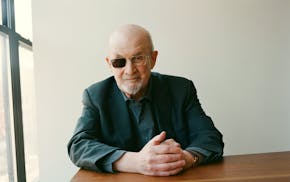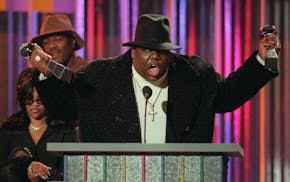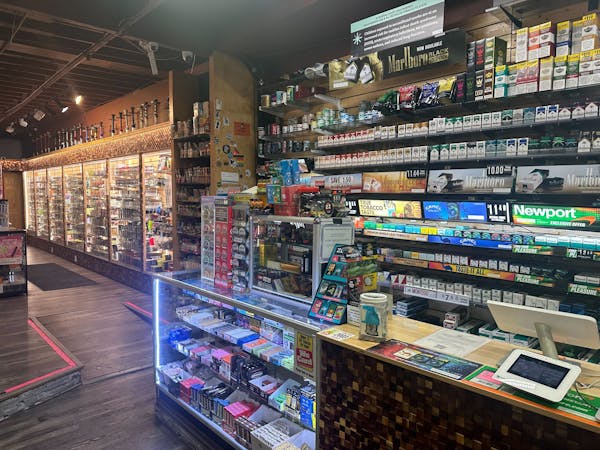College is conventionally a time to hone skills, figure out who you are, and party.
On the evidence of her handsome new show at All My Relations Gallery in south Minneapolis, Maggie Thompson must have totally neglected the last part of that formula. A 2013 graduate of the Rhode Island School of Design, one of the country's most rigorous art colleges, Thompson obviously aced the first two requirements for her BFA, leaving little time to waste on partying.
In "Where I Fit," her debut show as a textile artist, she demonstrates remarkably mature skills in weaving, knitting, screen printing and conceptual design. Like many American Indians, Thompson is of mixed heritage, a fact she deftly explores in her "Family Portrait." It consists of three long, rug-like weavings that vividly illustrate the "blood quantum" defining her identity as a Fond du Lac Ojibwe. Her father is three-fourths Ojibwe and her mother 100 percent Irish-German, which makes Thompson just three-eighths Ojibwe. Each of the wall-hung rugs is divided into eight horizontal bands of red or white, her father's Ojibwe blood represented by six red bands, hers by three, and her mother none.
On the simplest level, the bands echo charts that the federal Bureau of Indian Affairs traditionally used to explain the "blood quantum" that determined who is officially categorized as an Indian and therefore eligible for government benefits in various tribes. As different tribes require more or less "blood quantum" for membership, the matter is extremely controversial even within the Indian community. Even now, the sight of such charts is "either painful or a painful joke," said Dyani White Hawk Polk, who curated the exhibition.
Elsewhere Thompson used screen printing to stamp the words "Authentic Indian" onto cotton fabric along with outlines of feathers, shields, eagles, teepees, bottles and other motifs associated with Indian identity.
Plunging into more personal territory, in "Forgiving Our Fathers," she incorporates poetry and screen-printed photos of her father and other family members in a large star-quilt pattern, a traditional design used to honor an elder. She handwove red stripes into a black-and-white poncho as a statement of "strength and power," and ran a beautiful multicolored geometric design down the back of a hand-felted jacket.
On a more critical note, she tied beer caps to a revealing little dress of the sort that exotic dancers wear. The tinkling caps refer ironically to the pretty silver cones that decorate traditional jingle dresses, but allude here to what she calls the "cultural prostitution" by which traditional Indian ornament is exploited and degraded in mainstream pop culture.
In more than 30 fabric samples, Thompson demonstrates remarkable sensitivity to color and texture as she skillfully plaits synthetics (poly floss) and natural fibers (cotton, wool, palm leaves) into intricate jacquard and dobby weaves. The show would be a stunner as a midcareer retrospective, but for a recent college grad it's a triumph.
11 a.m.-6 p.m. Mon.-Fri.; 11 a.m.-3 p.m. Sat. Ends May 31 • free • All My Relations Arts, 1414 Franklin Av. E., Mpls. • 612-235-4970 • www.allmyrelationsarts.com
'Designing the Self' at Textile Center
Minnesota artist Anna Carlson also uses words in "Designing the Self," as she calls her show of original fabric and clothing at the Textile Center of Minnesota near the University of Minnesota.
Adept at dyeing and printing, Carlson uses the words "No" and "Subject to Change" as feminist and existential statements on fabric and clothing. By changing her color palette she deftly alters the psychological and visual implications of her designs. Vertical ribbons of the words "Subject to Change" in different colors ornament a classic cotton blouse, a diaphanous silk top, and run through a mossy-looking pattern on a bolt of fabric. "No" printed in bright colors on a little yellow "Defiance" dress perfectly sums up the independence asserted by the 2-year-olds for whom it's designed. But printed on the sexy silk slip hanging nearby, the word "No" seems like a more ambiguous "maybe."
In the center's main gallery, Philadelphia-based Leslie Pontz has installed crocheted bags and baskets made from synthetic and natural fibers — metallic silver and copper, translucent monofilament, silk, wool and other fibers. Attached to heavy metal hooks and stirrups, the bags dangle from the ceiling, collapse into cocoons, drape over pedestals and hold yarn-like balls of string, wood and so on.
The shifts in scale and contrasting textures — rough and smooth, translucent and opaque, industrial and handmade — suggest other opposites (masculine/feminine; air/water). And yet, for all their ambitious scale and the labor required to make them, these concoctions still read primarily as really big shopping bags rather than as the "sculptures" they aspire to be.
10 a.m.-7 p.m. Mon.-Thu.; 10 a.m.-5 p.m. Fri.-Sat. Ends May 31 • free • Textile Center, 3000 University Av. SE., Mpls. • 612-436-0464 • www.textilecentermn.org
Mary.Abbe@startribune.com • 612-673-4431
NPR suspends editor who criticized his employer for what he calls an unquestioned liberal worldview

Salman Rushdie's 'Knife' is unflinching about his brutal stabbing and uncanny in its vital spirit

